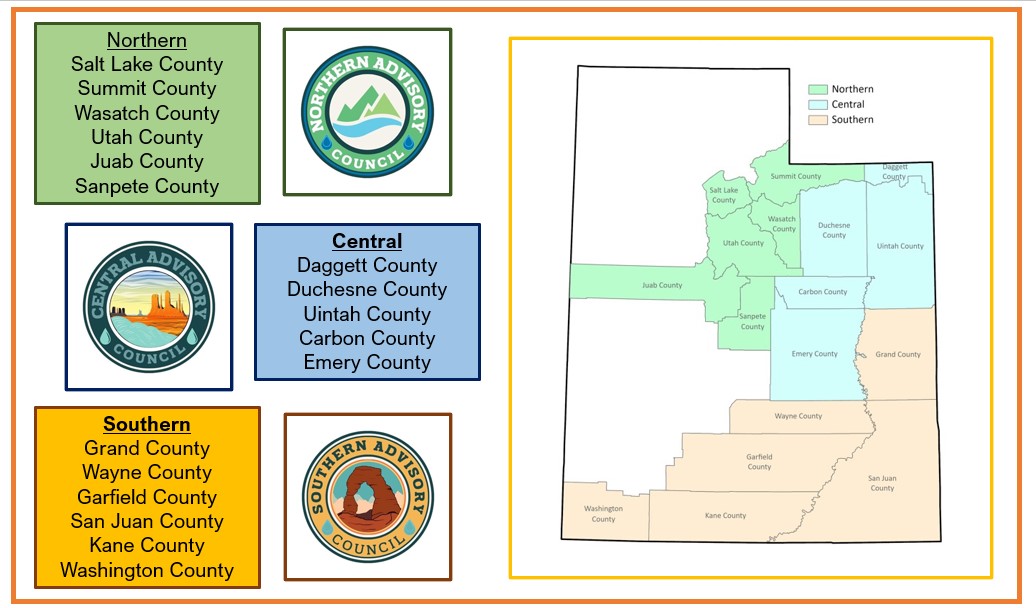Advisory Councils
The Colorado River Authority of Utah (Authority) advisory councils offer Utahns a unique opportunity to engage and participate in critical discussions related to the Colorado River.
Answers to common questions about the councils are included below:
Where did the idea of advisory councils emerge?
Utah’s legislature recognized the importance of stakeholder input and diverse perspectives to the Authority by codifying advisory councils within statutes.
UCA 63M-14-209 authorizes the Authority to create advisory councils to provide “data, information, and input… relevant to the mission and objectives of the authority.” The dialogue, discussions, and ideas generated by the advisory councils will help the Authority meet its objective to “protect, conserve, use, and develop Utah's waters of the Colorado River system.”
Who sits on the advisory councils and what do they do?
Councils comprise engaged citizens, stakeholders, subject-matter experts, and other Utahns who care deeply about the Colorado River. They gather information, provide study and analysis, and serve as a deliberative forum for diverse points of view. When appropriate, advisory councils can also gather data and provide information and analysis on specific topics.
While advisory councils are not vested with the authority to make decisions regarding public business, council perspectives do provide viewpoints and insights that help inform the River Commissioner and other officials.
What are the objectives of advisory councils?
Advisory councils provide an ongoing public forum for participants to share varied points of view, data, and possible scenarios to address Colorado River challenges. They also build trust and understanding between the Authority, stakeholders, and the public. Finally, advisory councils help ensure the River Commissioner and the Authority Board are continually updated on current issues and are provided various options and alternatives as they address the Colorado River's critical issues.
How are the advisory councils structured?
After consultation with Authority staff and various stakeholders, a geographic model was determined to be the council structure that offered the most effective means of organization. A geographic-based model enables issues to be localized, where participants in the councils have personal knowledge about local topics of interest. The geographic model also allows for customization within each council and makes it easier for participants to travel to and attend council meetings in their region.
Each council is based on a geographic region composed of the 17 counties listed in the Authority’s enabling legislation. All the Colorado River-related issues and challenges relevant to a specific council region are within each council's scope and purview.
Councils are organized as follows:

How can I apply to be an advisory council member?
If you are interested in participating in one of the three advisory councils, we invite you to fill out this application form. I appreciate your interest, and we look forward to reviewing your application. Please understand there are limited seats for each council, and we will select individuals with unique qualifications, knowledge, and experience within these specific geographic areas.
How will tribal considerations be addressed?
Native American tribes are sovereign entities, and Utah has over 40,000 Native Americans living there. Recently passed legislation, SB160, directs the Authority to engage with Tribes in a government-to-government fashion “on matters directly related to the Authority’s general statutory powers and mission…with all federally-recognized Indian Tribes located, in whole or in part, within the state and the Colorado River system." As such, the Authority fully intends to engage with the applicable Utah Tribes within the Colorado River system as indicated in the statute.
How will the councils operate?
It is anticipated that each council will be composed of roughly 7-11 members. Committees will meet at least four times each year, with designated joint meetings with the other councils to ensure an exchange of ideas and viewpoints. Council members will be tasked with seeking practical outcomes and recommendations. Agreed-upon rules of etiquette will be distributed to council members. Each council will also be provided with a template to structure feedback and facilitate consistent communication with the Authority Board.
On December 2, 2021, the Authority Board adopted the following advisory council rule to help guide council operations:
Advisory Council Rule--General
This rule is established under the authority of the Colorado River Authority of Utah Act, Section 63M-14-209, to provide the general standards and procedures for the operation of the Colorado River Authority of Utah (“Authority”) Advisory Councils.
Advisory Council Membership
(1) There is created one or more Advisory Councils that shall consist of members representing a variety of Colorado River interests in Utah.
(2) Advisory Councils will serve as a forum for civic engagement on the use, development, conservation, and protection of Utah’s Colorado River entitlement.
(3) Advisory Council Members may serve by appointment or by application.
(a) Each Advisory Council shall be governed by co-chairs, one selected by its membership and one selected by the Authority Board. The co-chairs will conduct meetings and present council recommendations to the Authority Board.
(b) Authority staff shall provide administrative support to all Advisory Councils.
Advisory Council Meetings
(1) Advisory Councils shall meet on dates and times as jointly determined by the co-chairs.
(2) Each Advisory Council shall:
(a) Hear broad input, including recommendations, data, and information regarding all matters affecting Utah’s Colorado River system water; and
(b) make recommendations to the Authority Board in an advisory capacity.
